A quick and easy dumpling dipping sauce you can serve with Japanese gyoza or potstickers. Just 4 ingredients, with extra ideas to make it your own. Use it with your favourite homemade or store-bought dumplings.
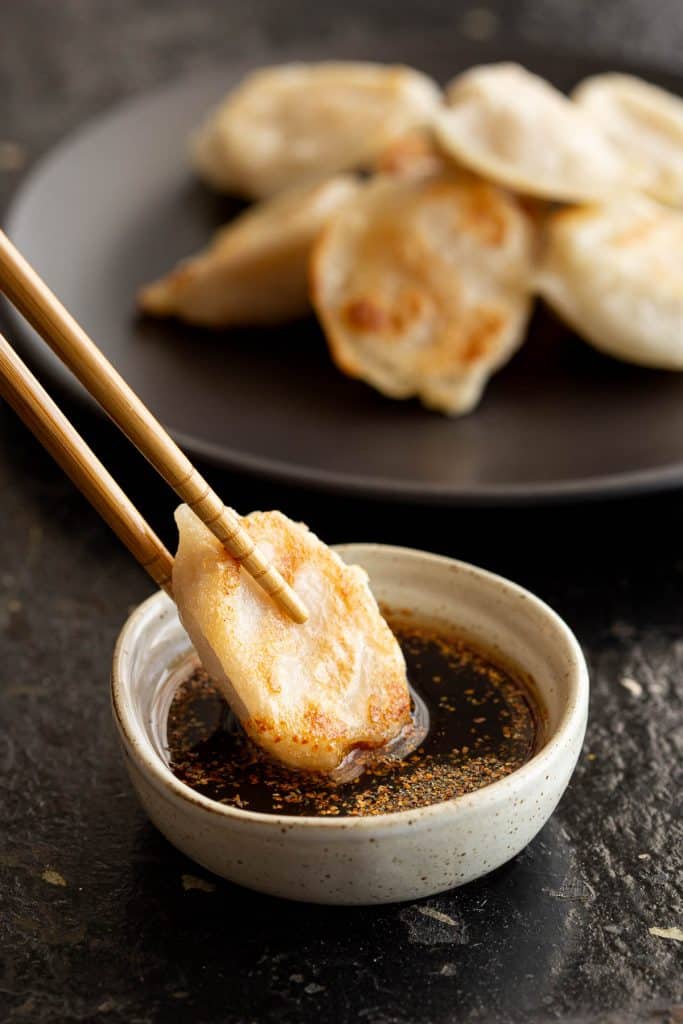
Why We Love This
This is a super quick homemade gyoza sauce with simple ingredients that work together to bring out the flavour in your dumplings.
No cooking or chopping required – you can whip it up in less than a minute!
We love mixing together a small bowl per person so everyone can enjoy the perfect balance of flavour for them.
Store-bought dumpling dipping sauces can be pretty expensive to buy. Once you master this recipe, you’ll always have fresh dipping sauce when you need it at a fraction of the cost!
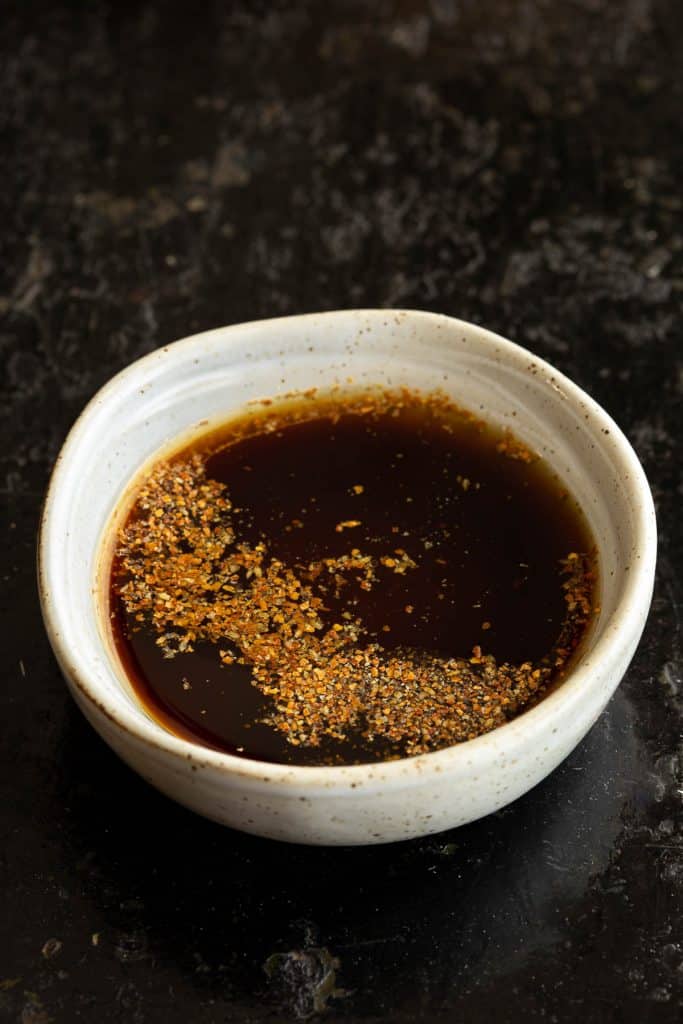
What is Gyoza Sauce?
Traditionally, gyoza sauce it is half soy sauce and half vinegar, with optional chilli. Our version adds a touch of sesame oil, which pairs perfectly with the acidic tang of vinegar and salty soy. It’s so easy to play with the ratios and adapt to your own personal taste. Once ready, just dip, drip off the excess and enjoy.
This dipping sauce is not just amazing for dumplings, splash it over almost anything. Try it over noodles or even swap out the ponzu in your homemade shabu shabu hot pot.
What You’ll Need
The 4 basic ingredients in this simplified dumpling sauce are listed below along with variations. This recipe uses basic Asian pantry staples that you may already have. While some brands or styles might give you better flavour than others, we encourage you to use whatever is available in your pantry so you can get dipping as quick as possible!
- Soy Sauce – Regular soy sauce (rather than light or dark soy) works best for this sauce, it has the perfect intensity of flavour. No stress if you need to use one of the other varieties, you just may need to add more or less to get the right balance. Tamari is also fine for a gluten-free option.
- Rice Wine Vinegar – For a more traditional flavour, make this with rice vinegar, which is a little sweeter than regular vinegar. You can substitute with apple cider vinegar, black vinegar or white wine vinegar if you need, but if you only have simple white vinegar on hand that will also do the trick. You may like to add a sprinkling of sugar for a hint of sweetness if you do.
- Sesame Oil – This is essential for its rich, nutty flavour. Choose a high quality brand for the best flavour as some sesame oils can have less flavour than others. Make your own homemade sesame oil in a pinch, or for an extra chilli kick, replace this with sesame based rayu chilli oil.
- Chilli Powder – You can use any kind of chilli powder, red pepper flakes, chilli paste, sambal or chilli oil. We’ll often use shichimi togarashi (Japanese 7 spice) because it has an even heat and a hint of citrus. You could always use slices of fresh chilli if you prefer – deseed them first if you think they might be too hot.
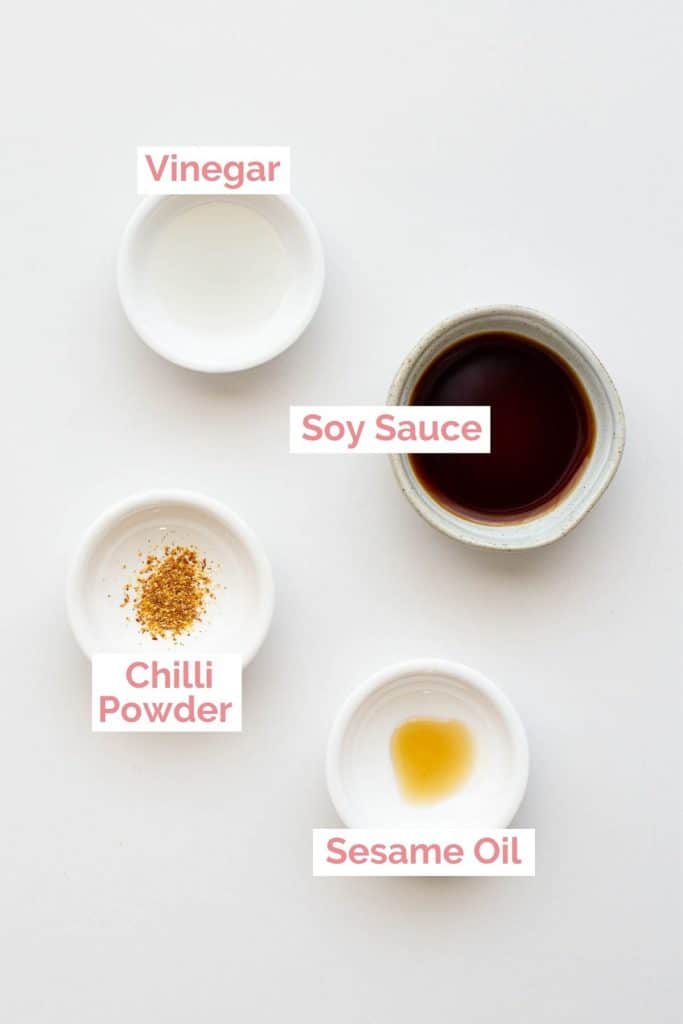
Wandercook’s Tips
- Individual Dipping Bowls – Our gyoza sauce recipe is for one small dipping bowl. You can double, triple, quadruple etc to have some now and keep some for later. Better yet, get each person to make their own batch in a separate dipping bowl and get the flavours just right for them. Some may like extra chilli, while others will want to leave it out completely.
- Only Keep ‘Clean’ Sauce – If you decide to make a bigger batch to keep for later, we recommend only pouring out what you need, and store the rest in an airtight container in the fridge. Discard any sauce that has been dipped in.
FAQs
Fresh, unused sauce will last for 2-3 days in the fridge when stored in an airtight container. We don’t recommend keeping sauce that has already been used for dipping.
Just about anything where you want to add some seriously delicious flavour! We love it with:
– Homemade gyoza / potsticker dumplings
– Thai crispy fried spring rolls
– Vietnamese fried rice paper spring rolls
– Dan bing tuna & egg crepes
– Hot simmered tofu
– As a dip for blanched bean shoots or veggies (perfect for Chinese greens like gai lan, bok choy, morning glory etc)
– Splash it over stir fries
Variations
- Flavour Upgrades – Grate fresh ginger and/or garlic straight into the bowls – it’s quicker and easier than slicing or chopping. You could also add a little sugar to sweeten the sauce if you like.
- Add Ponzu – For a citrus umami hit, add ponzu to the existing sauce, or use it instead of the regular soy sauce.
- Extra Heat – Add fresh chillies or your favourite hot chilli oil. Try Sichuan peppercorn oil for its delicious ‘numbing’ effect.
- Optional Garnish – Top with slices of fresh spring onion, crispy fried shallots, sesame seeds (toasted or regular) or a sprinkling of shichimi togarashi.
- Too Spicy? – Leave out the chilli.
- Too Salty? – Water down with a little warm water, use less soy sauce, or swap for a low sodium soy sauce.
- Too Intense? Add a splash of hot water to thin it out a bit.
- Different sauce? Try these other Japanese Sauces.
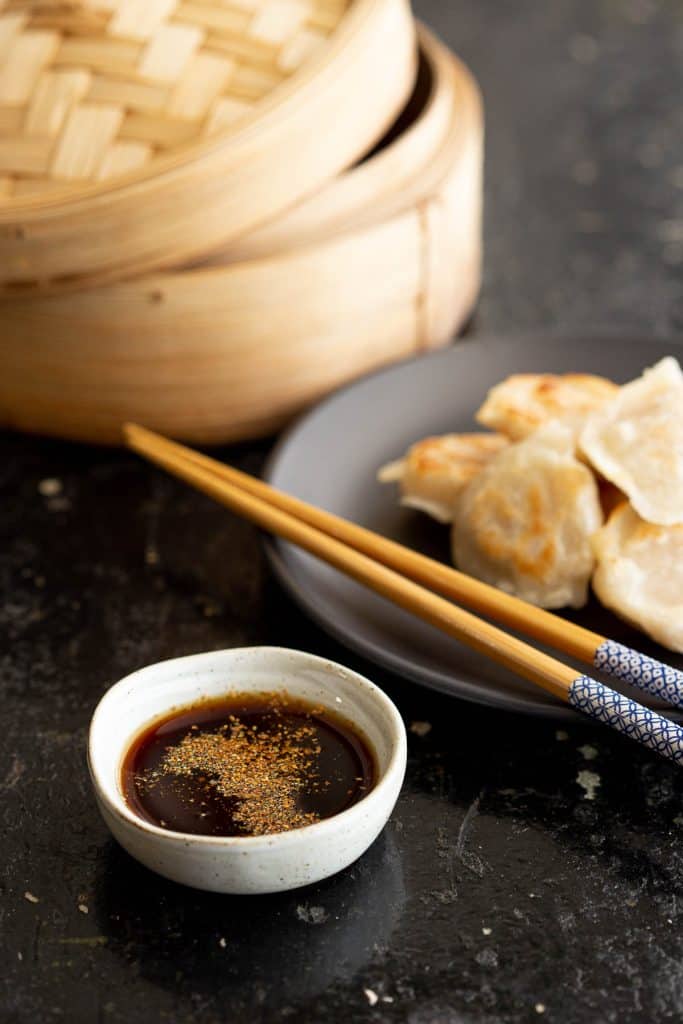
Serve your gyoza up with these popular Japanese bites:
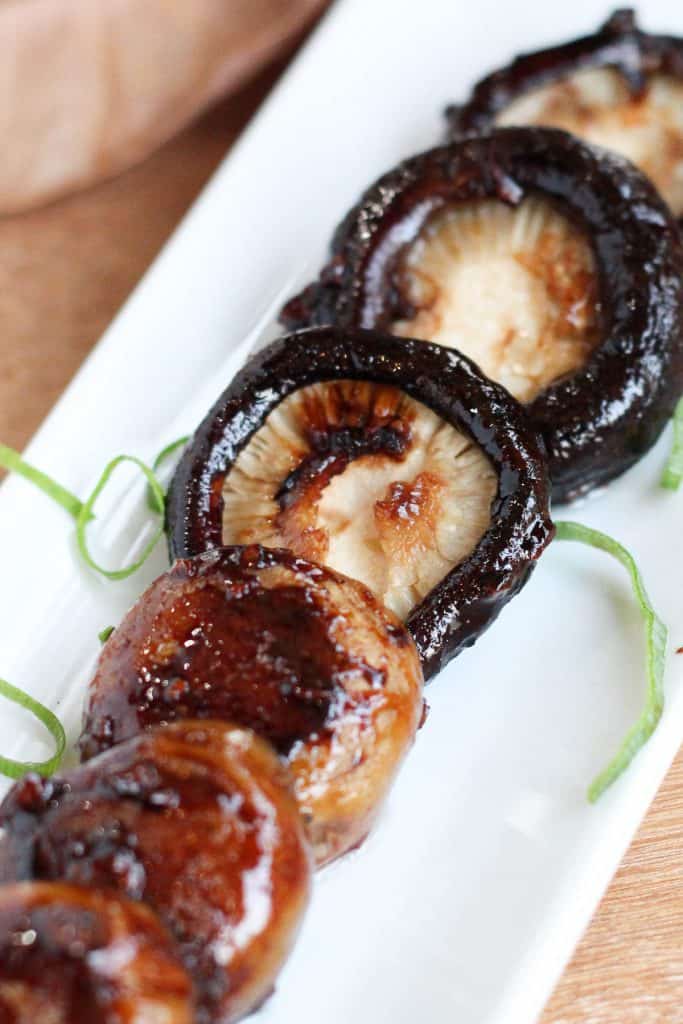
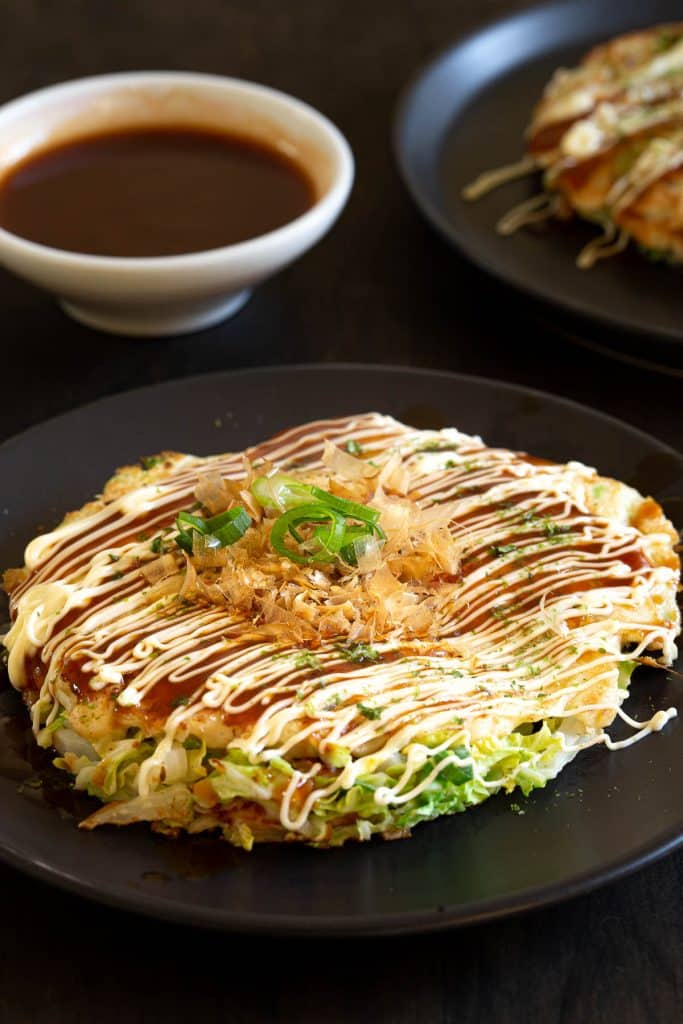
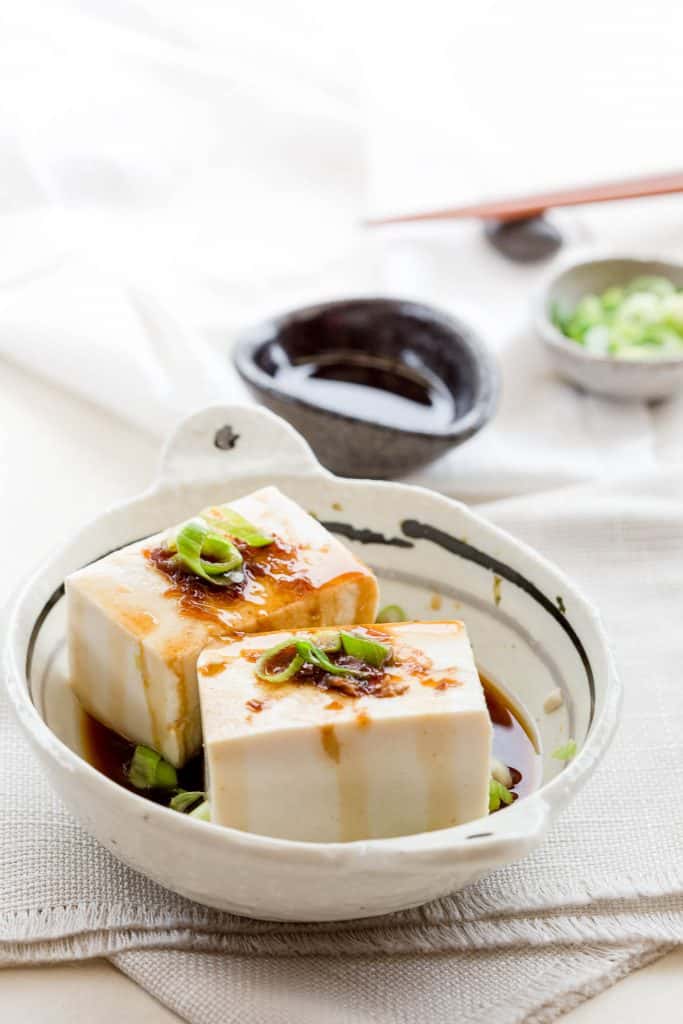
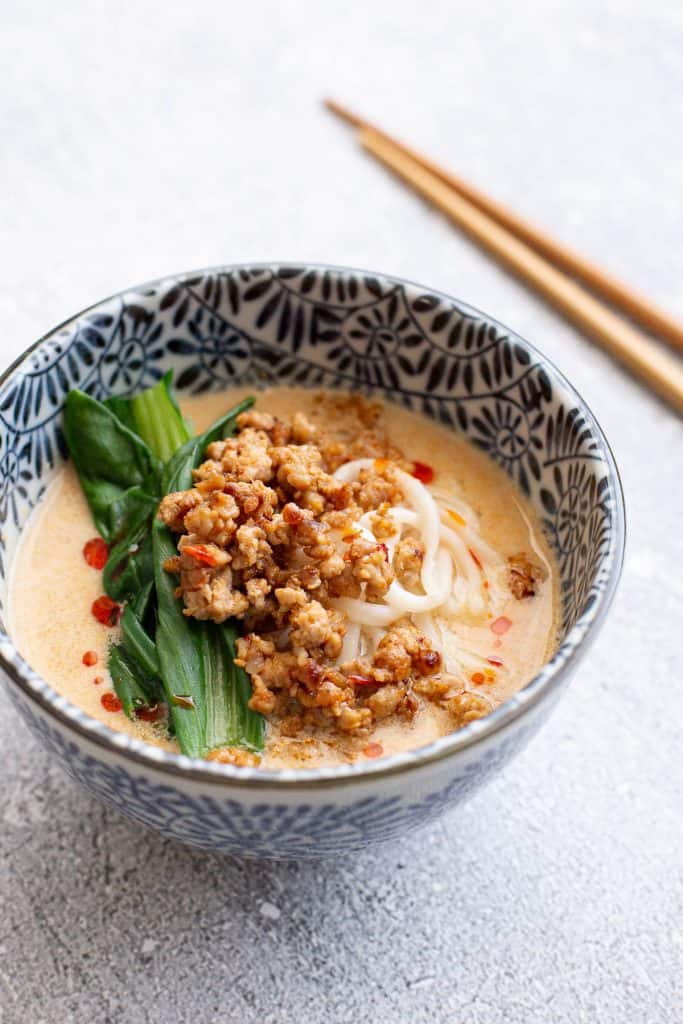
★ Did you make this recipe? Please leave a star rating below!
Equipment
Ingredients
- 1 tbsp soy sauce
- 1 tsp rice wine vinegar
- 1 tsp sesame oil
- chilli flakes to taste
Instructions
- In a small dipping bowl add your soy sauce, rice wine vinegar, sesame oil and chilli flakes.1 tbsp soy sauce, 1 tsp rice wine vinegar, 1 tsp sesame oil, chilli flakes
- Add any optional extras, give one final mix and serve with hot gyoza.sugar, garlic, ginger
Video
Recipe Notes
- Ingredient Tips –
- Soy Sauce – Regular soy sauce (rather than light or dark soy) works best for this sauce, it has the perfect intensity of flavour. No stress if you need to use one of the other varieties, you just may need to add more or less to get the right balance. Tamari is also fine for a gluten-free option.
- Rice Wine Vinegar – For a more traditional flavour, make this with rice vinegar, which is a little sweeter than regular vinegar. You can substitute with apple cider vinegar, black vinegar or white wine vinegar if you need, but if you only have simple white vinegar on hand that will also do the trick. You may like to add a sprinkling of sugar for a hint of sweetness if you do.
- Sesame Oil – This is essential for its rich, nutty flavour. Choose a high quality brand for the best flavour as some sesame oils can have less flavour than others. For an extra chilli kick, replace this with sesame based rayu chilli oil.
- Chilli Powder – You can use any kind of chilli powder, red pepper flakes, chilli paste, sambal or chilli oil. We’ll often use shichimi togarashi (Japanese 7 spice) because it has an even heat and a hint of citrus. You could always use slices of fresh chilli if you prefer – deseed them first if you think they might be too hot.
- Individual Dipping Bowls – Our gyoza sauce recipe is for one small dipping bowl. You can double, triple, quadruple etc to have some now and keep some for later. Better yet, get each person to make their own batch in a separate dipping bowl and get the flavours just right for them. Some may like extra chilli, while others will want to leave it out completely.
- Only Keep ‘Clean’ Sauce – If you decide to make a bigger batch to keep for later, we recommend only pouring out what you need, and store the rest in an airtight container in the fridge. Discard any sauce that has been dipped in.
- Flavour Upgrades – Grate fresh ginger and/or garlic straight into the bowls – it’s quicker and easier than slicing or chopping. You could also add a little sugar to sweeten the sauce if you like.
- Add Ponzu – For a citrus umami hit, add ponzu to the existing sauce, or use it instead of the regular soy sauce.
- Extra Heat – Add fresh chillies or your favourite hot chilli oil. Try Sichuan peppercorn oil for its delicious ‘numbing’ effect.
- Optional Garnish – Top with slices of fresh spring onion, crispy fried shallots, sesame seeds (toasted or regular) or a sprinkling of shichimi togarashi.
- Too Spicy? – Leave out the chilli.
- Too Salty? – Water down with a little warm water, use less soy sauce, or swap for a low sodium soy sauce.
- Too Intense? Add a splash of hot water to thin it out a bit.
- Storage – Fresh, unused sauce will last for 2-3 days in the fridge when stored in an airtight container. We don’t recommend keeping sauce that has already been used for dipping.
- Usage Ideas –
- Homemade gyoza / potsticker dumplings
- Thai crispy fried spring rolls
- Vietnamese fried rice paper spring rolls
- Dan bing tuna & egg crepes
- Hot simmered tofu
- As a dip for blanched bean shoots or veggies (perfect for Chinese greens like gai lan, bok choy, morning glory etc)
- Splash it over stir fries
Nutrition
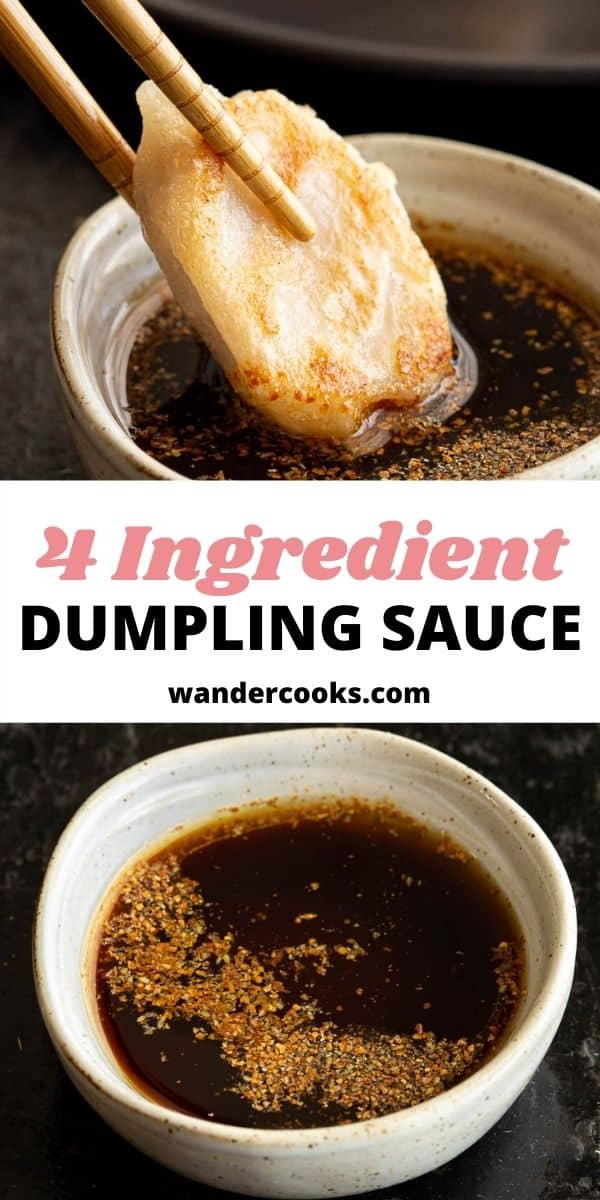

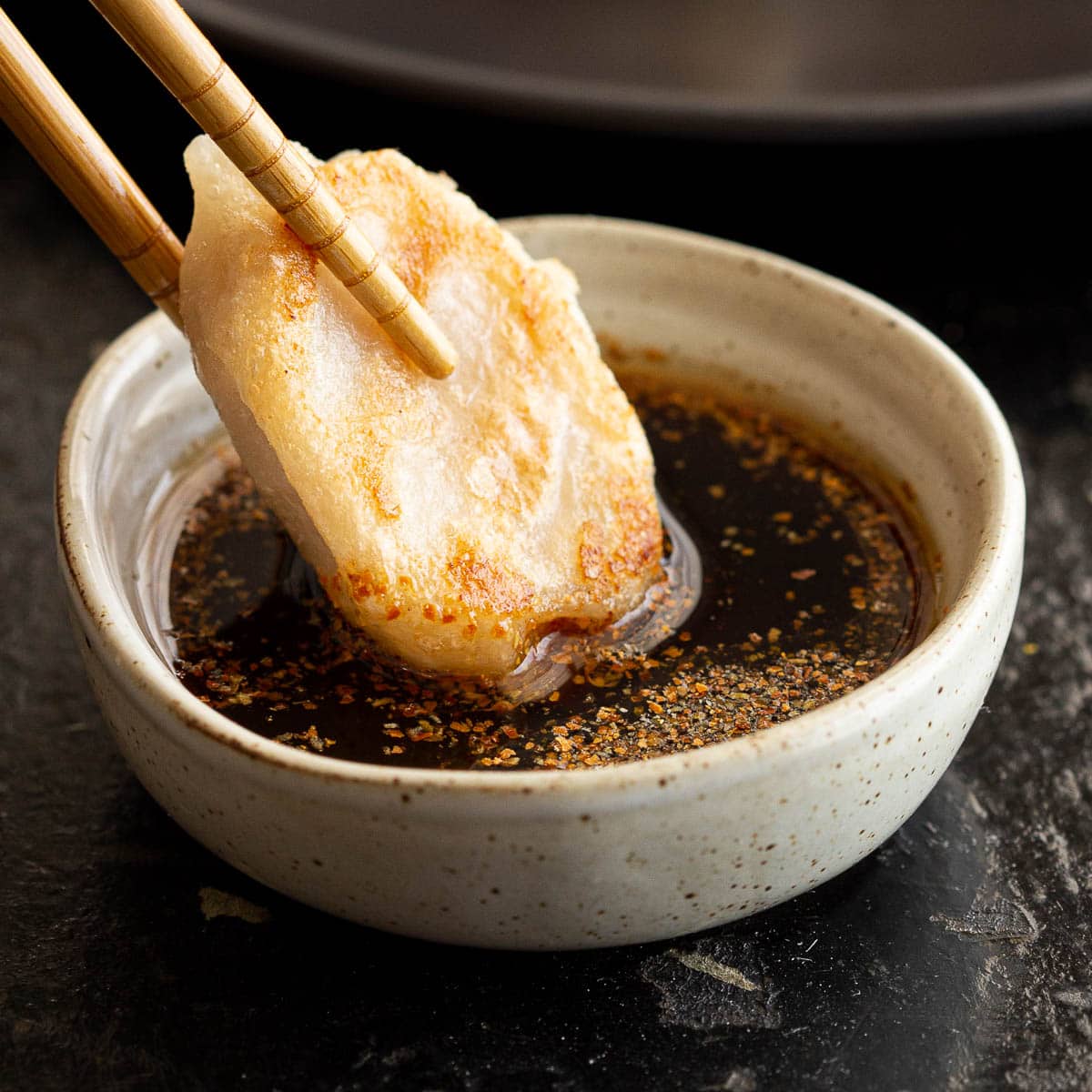



24 Comments
ERIKA JEFFRIES
02/01/2024 at 10:13 amIts perfect. Just what I was looking for. Thanks
Wandercooks
04/01/2024 at 9:35 amYou’re very welcome Erika!
txmissyd
27/07/2023 at 7:22 amThanks for the recipe. I have a question. In the description it says “What is Gyoza Sauce? Traditionally, gyoza sauce it is half soy sauce and half vinegar,” but the recipe is 1 TBSP soy sauce and 1 tsp vinegar. Is that correct to use less vinegar instead of half each?
Wandercooks
27/07/2023 at 9:02 amHey, that’s correct. What we’re saying is traditionally gyoza sauce is half and half, but we prefer less vinegar, which is why our recipe is different. You can of course put as much in as you prefer.
Carol
28/06/2023 at 11:00 pmThanks!!!
Wandercooks
29/06/2023 at 10:16 amYou’re welcome!
Kathy
14/05/2023 at 11:18 pmImmediately tried this recipe. A fact, it is easy and delicious. Your recipe is the best format and information I have yet to see. Thank you.
Wandercooks
16/05/2023 at 11:15 amYou’re very welcome Kathy, so glad you enjoyed!
Leanne
29/01/2023 at 8:47 pmFabulous dipping sauce! Thank you so much for the recipe 😘 Like being at the restaurant in the comfort of your own home, cant wait to try more recipes 😋
Wandercooks
30/01/2023 at 11:13 amAww thanks Leanne! You’re very welcome. Let us know what you cook next!
Elizabeth
22/09/2022 at 1:37 amMade some handmade dumplings and needed a quick sauce that I had all of the ingredients for. This sauce turned out amazing and will definitely be my go to for the next time I make dumplings. Great recipe!
Wandercooks
22/09/2022 at 12:27 pmThat’s great Elizabeth! Glad you enjoyed it. 🙂
Kirsten Moss
20/11/2021 at 6:13 pmMy 7 year old daughter made this – it is delicious! Thank you for the recipe.
Wandercooks
22/11/2021 at 1:36 pmThat’s so good Kirsten! Thanks for sharing, and so happy you all enjoyed it. 🙂
George
18/11/2021 at 11:43 amI dont even have a kitchen!!!!!!
Wandercooks
19/11/2021 at 3:57 pmGlad to hear you didn’t need one to make this – nice and easy! 😀
Biff Tanner
11/11/2021 at 7:54 am4 Ingredients? Looks like 7…
Wandercooks
12/11/2021 at 11:02 amOnly 4 Biff – Soy sauce, rice wine vinegar, sesame oil and chilli flakes. This is the staple we usually use – we’ve then added the optional extras that some people like to add – like garlic and ginger. 🙂
Anonymous
09/11/2021 at 10:12 pmThis is so delicious!
Wandercooks
12/11/2021 at 11:03 amThank you!
Jeremy
21/10/2021 at 5:28 amYou guys are a lifesaver with these great recipes. Your travels have really paid off it seems, just absolutely wonderful tastes you’ve collected from all over, it’s magical!
I see that you have both a Ponzu Dipping Sauce recipe and a Gyoza Dipping Sauce recipe, are these distinctly different? Are they interchangeable? In the typical Japanese restaurant which one is it they serve with an order of Gyoza?
Again, thank you so much for sharing.
Wandercooks
21/10/2021 at 10:44 amHey Jeremy, thanks for the feedback and that’s a great question!
SO! There is a big difference between the two:
Gyoza Dipping Sauce is what you’ll find with your gyoza at a typical Japanese restaurant. It is soy sauce based but has vinegar added to give it the flavour kick (and the optional hot pepper powder).
Ponzu Sauce is also sometimes served with gyoza, which is where it is tricky, but while it’s also soy sauce based, it’s mixed with lemon or yuzu juice to get it’s tang instead. Ponzu you’ll find is more commonly paired with Japanese hot pot known as Shabu Shabu as one of two dipping sauces – goma dare being the other one.
I hope this clarifies things and you enjoy your taste testing!
Zaina
24/03/2021 at 11:53 amSo good yes ran out of the one that came in the frozen package so tried this it’s pretty much exact!
Wandercooks
24/03/2021 at 12:51 pmBrilliant Zaina, so glad we could help. 😀 Enjoy your gyoza!